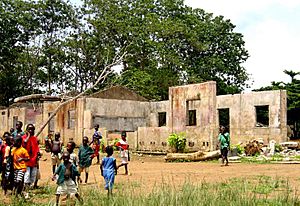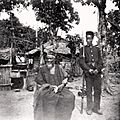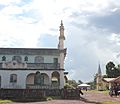Sierra Leone facts for kids
Quick facts for kids
Republic of Sierra Leone
|
|
|---|---|
|
|
|
|
Motto: "Unity, Freedom, Justice"
|
|
|
Anthem: "High We Exalt Thee, Realm of the Free"
|
|

Location of Sierra Leone (dark green)
|
|
| Capital and largest city
|
Freetown 08°30′00″N 12°06′00″W / 8.50000°N 12.10000°W |
| Official languages | English |
| Recognised national languages | Krio |
| Ethnic groups
(2015)
|
|
| Demonym(s) | Sierra Leonean |
| Government | Unitary presidential republic |
| Julius Maada Bio | |
| Mohamed Juldeh Jalloh | |
|
• Chief Minister
|
David Sengeh |
| Legislature | Parliament |
| Independence
from the United Kingdom
|
|
|
• Dominion
|
27 April 1961 |
|
• Republic
|
19 April 1971 |
| Area | |
|
• Total
|
71,740 km2 (27,700 sq mi) (117th) |
|
• Water (%)
|
1.1 |
| Population | |
|
• 2023 estimate
|
8,908,040 (100th) |
|
• Density
|
112/km2 (290.1/sq mi) (114tha) |
| GDP (PPP) | 2023 estimate |
|
• Total
|
|
|
• Per capita
|
|
| GDP (nominal) | 2023 estimate |
|
• Total
|
|
|
• Per capita
|
|
| Gini (2018) | 35.7 medium |
| HDI (2021) | low · 181st |
| Currency | Leone (SLL) |
| Time zone | UTC (GMT) |
| Date format | dd/mm/yyyy |
| Driving side | right |
| Calling code | +232 |
| ISO 3166 code | SL |
| Internet TLD | .sl |
|
|
Sierra Leone is a country in West Africa. Its capital is Freetown. The official language is English.
The country was first made as a place where freed slaves could live. From 1991 until 2000, there was a civil war in Sierra Leone between rebels and the government. The war is now over. Sierra Leone is known for its blood diamonds. These were mined and sold during the civil war. This was in order to buy the weapons for the civil war.
There are 71,740 square kilometres of land in Sierra; In terms of land area it is similar in size to Ireland.
Sierra Leone has relied on mining, especially diamonds, for its economic base. The country is among the largest producers of titanium and bauxite, and a major producer of gold. The country has one of the world's largest deposits of rutile. Sierra Leone is also home to the third largest natural harbour in the world. Shipping from all over the globe goes to Freetown's famous Queen Elizabeth II Quay. Despite this natural wealth, 70% of its people live in poverty.
Sierra Leone is a mostly Muslim country.
The country has 2,090 known species of higher plants, 147 mammals, 626 birds, 67 reptiles, 35 amphibians, and 99 fish species.
Contents
Etymology
The country takes its name from the Lion Mountains near Freetown. Originally named Serra Leoa (Portuguese for 'lioness mountains') by Portuguese explorer Pedro de Sintra in 1462, the modern name is derived from the Venetian spelling, which was introduced by Venetian explorer Alvise Cadamosto and subsequently copied by other European mapmakers.
Geography and climate
The country is bordered by Guinea to the north and northeast, Liberia to the south and southeast, and the Atlantic Ocean to the west.
Mount Bintumani reaches 1,948 m (6,391 ft). It is the highest point in the country.
The climate is hot, tropical and humid all year round, with two seasons. The rainy season is from May to November, and the dry season is from December to May.
March & April are the hottest months and daytime temperatures are around 38 °C (100 °F) - 41 °C (106 °F) with a solid 82% humidity. Night time temperatures do not vary a lot and may fluctuate by 2 °C - 4 °C.
December and January are prefably the best times to visit Sierra Leone as temperatures and humidity are much lower and reasonable due to the hammattan breeze from the sahara desert, although afternoon temperatures can still climb up to 40 °C and above, the hammattan breeze stops it from getting too humid, even though it will still be hot, humidity would be can be lowered down to 39% meaning you'll sweat less during this time than you would when the climate goes back to its original state, so therefore the heat would be more endurable especially around coastal areas.
When the hammattan breeze has lowered the heat and the humidity to its base, the highest average daily temperature in December and January will only reach a maximum of 31 °C (88 °F) and night time temperatures will be 24 °C (75 °F), although it can seldomly drop down to 21 °C (70 °F) at night, and sometimes in the morning which is the lowest the temperature can get. During this time, humidity is 70% & it is pleasantly warm and enjoyable.
The rainy season from May-November, average temperatures are 27 °C (81 °F) - 29 °C (84 °F) with humidity 95% - 100%. Some days when it doesn't rain, temperatures can climb up to 32 °C (90 °F) and humidity can be moderate around 75%. Rainfall can be torrential, so if you're travelling to Sierra Leone around this time of the year, it is advisable to bring water proof clothing as it can rain for a whole week without interruption from sunlight.
Largest cities
The largest cities in Sierra Leone are:
- Freetown 1,070,200
- Bo 269,000
- Kenema 158,496
- Koidu Town 111,800
- Makeni 105,900
Government and politics
Sierra Leone is a constitutional republic with a directly elected president and a unicameral legislature. The current system of the Government of Sierra Leone is based on the 1991 Sierra Leone Constitution. Sierra Leone has a dominant unitary central government and a weak local government. The executive branch of the Government of Sierra Leone, headed by the president of Sierra Leone has extensive powers and influence. The president is the most powerful government official in Sierra Leone.
Within the confines of the 1991 Constitution, supreme legislative powers are vested in Parliament, which is the law-making body of the nation. Supreme executive authority rests in the president and members of his cabinet and judicial power with the judiciary of which the Chief Justice of Sierra Leone is the head.
The president is the head of state, the head of government, and the commander-in-chief of the Sierra Leone Armed Forces. The president appoints and heads a cabinet of ministers, which must be approved by the Parliament. The president is elected by popular vote to a maximum of two five-year terms. The president is the highest and most influential position within the government of Sierra Leone.
To be elected president of Sierra Leone, a candidate must gain at least 55% of the vote. If no candidate gets 55%, there is a second-round runoff between the top two candidates.
Education
Education in Sierra Leone is legally required for all children for six years. A shortage of schools and teachers has made this impossible. Two thirds of the adult population of the country are not able to read. The Sierra Leone Civil War caused the destruction of 1,270 primary schools. In 2001, 67% of all school-age children were out of school. This has been better since the end of the civil war.
The country has three universities: Fourah Bay College, University of Makeni and Njala University. Teacher training colleges and religious seminaries are found in many parts of the country.
Provinces and districts
The Republic of Sierra Leone has five regions the Northern Province, North West Province, Southern Province, the Eastern Province and the Western Area. The first four provinces are divided into 14 districts. The districts are further divided into 149 chiefdoms.
| District | Capital | Area km2 | Province | Population (2004 census) | Population (2008 estimates) |
|---|---|---|---|---|---|
| Bombali District | Makeni | 7,985 | Northern Province | 408,390 | 424,100 |
| Koinadugu District | Kabala | 12,121 | 265,758 | ||
| Port Loko District | Port Loko | 5,719 | 455,746 | 483,752 | |
| Tonkolili District | Magburaka | 7,003 | 347,197 | 370,425 | |
| Kambia District | Kambia | 3,108 | 270,462 | 299,725 | |
| Kenema District | Kenema | 6,053 | Eastern Province | 497,948 | 522,656 |
| Kono District | Koidu Town | 5,641 | 335,401 | ||
| Kailahun District | Kailahun | 3,859 | 358,190 | 389,253 | |
| Bo District | Bo | 5,473.6 | Southern Province | 463,668 | 527,131 |
| Bonthe District | Mattru Jong | 3,468 | 129,947 | 137,155 | |
| Pujehun District | Pujehun | 4,105 | 228,392 | 262,073 | |
| Moyamba District | Moyamba | 6,902 | 260,910 | ||
| Western Area Urban District | Freetown | 3,568 | Western Area | 1,272,873 | 1,473,873 |
| Western Area Rural District | Waterloo | 4,175 | 174,249 | 205,400 |
Tourism
Sierra Leone's Freetown is a favourite destination for tourists. Although the sector was seriously affected during the Civil War, there has been a steady improvement in recent years. The city has a lot to offer to tourists. There is a vast expanse of beaches stretching along the Freetown Peninsula. The Lumley-Aberdeen beach stretches all the way from Cape Sierra Leone down to Lumley. There are also other popular beaches like the world renowned River Number 2 Beach, Laka Beach, Tokeh Beach, Bureh Beach, and Mama Beach. The Tacugama Chimpanzee Sanctuary, which is located within the peninsula's vast rainforest reserve, just a few kilometres from the centre of Freetown, has a collection of rare and endangered chimpanzees. Other popular destinations for tourists include the Freetown Cotton Tree, located in Central Freetown, a significant national monument and integral to the founding of the city; Bunce Island, which is a boat ride from the city, is home to the ruins of the slave fortress that was being used during the Transatlantic slave trade; the Sierra Leone Museum, which has a collection of both precolonial as well as colonial artifacts and other items of historical significance; the National Railway Museum; or take a journey around the city's coastline with the popular Sea Coach Express. The Aberdenn-Lumley area is a favourite destination for those venturing into the city's nightlife.
Food and customs
Rice is the staple food of Sierra Leone. It is eaten at nearly every meal daily. The rice is prepared in many ways, and topped with different sauces made from some of Sierra Leone's favorite toppings. These include potato leaves, cassava leaves, crain crain, okra soup, fried fish and groundnut stew.
Along the street of towns and cities one can find snacks such as fresh mangoes, oranges, pineapple, fried plantains, ginger beer, fried potato, fried cassava with pepper sauce; small bags of popcorn or peanuts, bread, roasted corn, or skewers of grilled meat or shrimp.
Poyo is a popular Sierra Leonean drink. It is a sweet, lightly fermented palm wine. Poyo bars are areas of lively informal talk about politics, football, entertainment and other issues.
Sports
Football is by far the most popular sport in Sierra Leone. Children, youth and adult are often seen playing street football across Sierra Leone.
The Sierra Leone national football team, popularly known as the Leone Stars, represents the country in international competitions. It has never qualified for the FIFA World Cup. They were in the 1994 and 1996 African Cup of Nations. Many of the national team footballers are celebrities across Sierra Leone. They are often well known by most of the country's general population. Some well known Sierra Leonean international footballers include Mohamed Kallon, Mohamed Bangura, Rodney Strasser, Ibrahim Teteh Bangura, Alhassan Bangura, Sheriff Suma, Mohamed Kamara, Umaru Bangura and Kei Kamara.
Related pages
Images for kids
-
Fragments of prehistoric pottery from Kamabai Rock Shelter
-
Bunce Island, 1805, during the period the slave factory was run by John and Alexander Anderson
-
British West African Campaign troops in Freetown, 1914–1916. Published caption: "British expeditionary force preparing to embark at Freetown to attack the German Cameroons, the main object of the attack being the port of Duala. Auxiliary native troops were freely used in African warfare."
-
A farmer with his rice harvest in Sierra Leone. Two-thirds of Sierra Leone's population are directly involved in subsistence agriculture.
-
Isata Mahoi shown editing radio programmes in Talking Drum studio Freetown; she is also an actress in the Sierra Leone radio soap opera Atunda Ayenda
-
National Stadium in Freetown.
-
Odelay mask by Temne people. Brooklyn Museum.
See also
 In Spanish: Sierra Leona para niños
In Spanish: Sierra Leona para niños

























